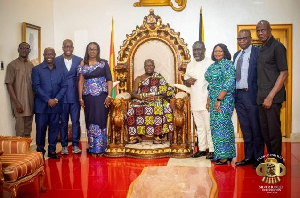- Home - News
- TWI News | TV
- Polls
- Year In Review
- News Archive
- Crime & Punishment
- Politics
- Regional
- Editorial
- Health
- Ghanaians Abroad
- Tabloid
- Africa
- Religion
- Election 2020
- Coronavirus
- News Videos | TV
- Photo Archives
- News Headlines
- Press Release
Business News of Tuesday, 10 September 2013
Source: B&FT
Pay revenue on silver as by-product - Toni Aubynn

Dr. Toni Aubynn, CEO of Ghana Chamber of Mines, has endorsed calls for mining companies to pay the required revenue on silver as a by-product in processing gold.
The 2010/2011 Ghana Extractive Industry Transparency Initiative (GHEITI) report says some mining companies derive silver as a by-product from gold processing but silver revenue is not included in the computation of royalty and recommended companies pay revenue as such.
Speaking to the B&FT at a sensitisation workshop in Sunyani, Dr. Aubynn said mining companies must pay the necessary revenue once they sell silver as a by-product, though it might be minute. “The law states that any mineral that a company mines, government must get its fair share of that production. What I know is that the silver content is very small -- but if they sold it, they must definitely pay the appropriate rent and royalty.”
On the issue of ring-fencing, he said government’s mode of implementing the policy is not practicable against the complex nature of the mining industry. Government intends to ring-fence mining concessions and projects to prevent companies from offsetting costs in one concession area or project against revenues from another.
But the Chamber of Mines boss argues ring-fencing can be effectively implemented against operations of companies but not concessions or projects. “Sometimes you have one operating plant and take ore from different places and blend to produce. So if you are ring-fencing, is it against the places the company takes the ore?” he asked rhetorically.
“It is difficult to demarcate the various factor contributions such as labour costs at different places. We have discussed with the Minerals Commission and the Ghana Revenue Authority (GRA) to fashion out a practical way of implementing the policy, and are very optimistic that they will take our outlook into consideration,” he said.
The Chamber, Dr. Aubynn stressed, does not oppose to ring-fencing; but if government still holds its position of rolling-out the policy, then it should be pegged against mining operations but not concessions or projects as suggested.
According to the International Council on Mining and Metals (ICMM), the political class does not understand mining’s complete range of benefits well -- whilst companies are also failing to express them well, hence such discrepancies in the enactment of mining revenue laws like ring-fencing.
Moreover, these gaps, Dr. Aubynn observed, are opening up at a time when mining’s cost curve has over-passed the price curve. He said “Whilst the price of gold has softened, costs of inputs don’t tend to trend down in tandem. Gold price is down by about 23% since October 2012’s high of US$1791.75 per ounce. In June 2013, the price of the metal dropped to US$1,192.00 per ounce.”
Consequences of an unfavourable fiscal environment and declining gold price, he said, pushed companies to review exploration, production expansion plans as well as greenfields with preference for those that provide optimal returns to them, making capital investments and allocations quite critica; and therefore any new “unfriendly” policy, such as government’s planned ring-fencing, will complicate mining companies’ fiscal problems.










